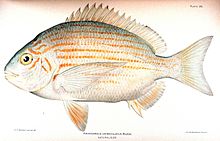Western Atlantic seabream
| Western Atlantic seabream | |
|---|---|

| |
| Scientific classification | |
| Domain: | Eukaryota |
| Kingdom: | Animalia |
| Phylum: | Chordata |
| Class: | Actinopterygii |
| Order: | Spariformes |
| Family: | Sparidae |
| Genus: | Archosargus |
| Species: | A. rhomboidalis
|
| Binomial name | |
| Archosargus rhomboidalis | |
| Synonyms[2] | |
| |
Western Atlantic seabream (Archosargus rhomboidalis) is an ocean-going species of fish in the family, Sparidae. It was first described in 1758 by the "father of modern taxonomy," Carl Linnaeus, in the 10th edition of his book, Systema Naturae. Within their native range, Western Atlantic seabream are also known as the seabream,[3] brim,[4] tropical sheepshead,[4] chopa amarilla,[5] or salema.[4] Although they are eaten, and have been described as pan fish, Western Atlantic seabream have not gained the popularity as a gamefish that their relative, the sheepshead (A. probatocephalus) has.[6]
Taxonomy and naming[edit]

Carl Linnaeus described the Western Atlantic seabream in the 1758 edition of Systema Naturae.[7] It was originally placed in Perca, a genus currently containing three species of freshwater fishes, such as the yellow perch and European perch. It was later moved to the genus Archosargus. The German naturalist Marcus Elieser Bloch described this species in his work, Allgemeine Naturgeschichte der Fische (General Natural History of Fishes), under the name Archosargus unimaculatus in 1792, which is now considered an "ambiguous synonym".[8]
Description[edit]
The Western Atlantic seabream is similar to other members of its genus, such as the sheepshead. They differ in that they are smaller,[9] have several horizontal blue streaks, mixed with gold or yellow, and a dark spot at the shoulder.[9] It does have vertical crossbars, like the Sheepshead, but they disappear with age.[5]
The maximum published length of a Western Atlantic seabream is 33 centimetres (13 in),[10] though they usually grow to about 20 centimetres (7.9 in).[11] The heaviest was recorded to weigh 0.55 kilograms (1.2 lb).[11] Western Atlantic seabream have nine spines on their dorsal fins, and 10–11 soft rays. On their anal fins, they have only three spines, but the same number of rays.[12] The large intestine of the Western Atlantic seabream makes up roughly 90% of the length of its entire digestive tract.[13] Males and females can be distinguished by the color of their pelvic fins: in males, the fin is partially or totally dark, while in females it is an orange color.[13]
Distribution and habitat[edit]

Western Atlantic seabream are known from waters off New Jersey and the northern Gulf of Mexico, south to Argentina.[14] Oddly, they are not found near the Bahamas,[13] though they are known from many other parts of the West Indies.[5]
They are commonly found in mangrove swamps, and in muddy, or vegetated bottoms. They are occasionally found in brackish water, and over reefs near mangroves. Western Atlantic seabream feed mainly on small, benthic invertebrates, such as bivalves, crustaceans and aquatic plants[12] and can live up to two years in the wild.[15]
References[edit]
- ^ Russell, B.; Carpenter, K.E.; MacDonald, T.; Vega-Cendejas, M. (2014). "Archosargus rhomboidalis". IUCN Red List of Threatened Species. 2014: e.T170156A1283528. doi:10.2305/IUCN.UK.2014-3.RLTS.T170156A1283528.en. Retrieved 15 July 2023.
- ^ "Archosargus rhomboidalis (Linnaeus, 1758)". Global Biodiversity Information Facility. Retrieved 15 July 2023.
- ^ Nelson, J.S., E.J. Crossman, H. Espinosa-Pérez, L.T. Findley, C.R. Gilbert, R.N. Lea and J.D. Williams 2004 Common and scientific names of fishes from the United States, Canada, and Mexico. American Fisheries Society, Special Publication 29, Bethesda, Maryland.
- ^ a b c Zaneveld, J.S. 1983 Caribbean Fish Life. Index to the local and scientific names of the marine fishes and fishlike invertebrates of the Caribbean area (Tropical Western Central Atlantic Ocean) E.J. Brill / Dr. W. Backhuys, Leiden, 163 p.
- ^ a b c Jordan, David Starr; B.W. Evermann (1905). American Food and Game Fishes. New York. pp. 441–442.
{{cite book}}: CS1 maint: location missing publisher (link) - ^ "Sheepshead". Smithsonian Marine Station.
- ^ Linnaeus, C. 1758 (1 Jan.) Systema Naturae, Ed. X. (Systema naturae per regna tria naturae, secundum classes, ordines, genera, species, cum characteribus, differentiis, synonymis, locis. Tomus I. Editio decima, reformata.) Holmiae. Systema Naturae, Ed. X. v. 1: i–ii + 1–824.
- ^ Randall, J.E. and R. Vergara R. 1978 Sparidae. In W. Fischer (ed.) FAO species identification sheets for fishery purposes. Western Central Atlantic (Fishing Area 31). FAO, Rome. Vol. 5. pag.var.
- ^ a b Jordan, David Starr (1905). A Guide to the Study of Fishes. Vol. 2. New York. p. 346.
{{cite book}}: CS1 maint: location missing publisher (link) - ^ Robins, C.R. & G.C. Ray (1986). A field guide to Atlantic coast fishes of North America. Boston, U.S.A.: Houghton Mifflin Company. p. 354.
- ^ a b Cervigón, F. 1993 Los peces marinos de Venezuela. Volume 2. Fundación Científica Los Roques, Caracas, Venezuela. 497 p.
- ^ a b Froese, Rainer; Pauly, Daniel (eds.) (2009). "Archosargus rhomboidalis" in FishBase. 10 2009 version.
- ^ a b c Smith, C.L. 1997 National Audubon Society field guide to tropical marine fishes of the Caribbean, the Gulf of Mexico, Florida, the Bahamas, and Bermuda. Alfred A. Knopf, Inc., New York. 720 p.
- ^ Hureau, J.-C. 1991 La base de données GICIM : Gestion informatisée des collections ichthyologiques du Muséum. pp. 225–227. In Atlas Préliminaire des Poissons d'Eau Douce de France. Conseil Supérieur de la Pêche, Ministère de l'Environnement, CEMAGREF et Muséum national d'Histoire naturelle, Paris.
- ^ Chavance, P.; A. Yañez-Arancibia; D. Flores-Hernández; A.L. Lara-Domínguez & F.A. Linares (1986). Ecology, biology and population dynamics of Archosargus rhomboidalis (Pisces, Sparidae) in a tropical coastal lagoon system, southern Gulf of Mexico.

